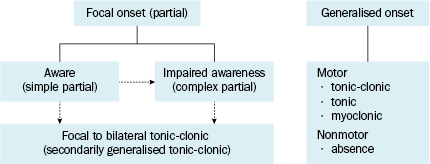Epilepsy classification
Epilepsy is a disorder characterised by a tendency to experience recurrent seizures. The International League Against Epilepsy's1 definition is 'a disease of the brain defined by:
- at least two unprovoked (or reflex) seizures occurring more than 24 hours apart
- one unprovoked (or reflex) seizure and a probability of further seizures similar to the general recurrence risk (at least 60%) after two unprovoked seizures, occurring over the next 10 years
- diagnosis of an epilepsy syndrome.'
Epilepsy can be the primary problem or a symptom of another brain disorder (eg brain tumour, injury, stroke). About half the patients who have a seizure for the first time do not have another, and do not have epilepsy.
Epilepsy consists of many syndromes or diseases2, defined by seizure type and associated features (eg age of onset, timing of seizures, seizure precipitation, clinical course, response to treatment). Epileptic seizures are best considered a symptom of an epileptic disorder. Focal (partial) seizures start in one cerebral hemisphere. Generalised seizures start in, and rapidly engage, networks that are bilaterally distributed. Generalised seizures usually appear to start in both hemispheres simultaneously.
[NB1] [NB2]

NB1: Adapted with permission from Fisher RS, Cross JH, D'Souza C, French JA, Haut SR, Higurashi N, et al. Instruction manual for the ILAE 2017 operational classification of seizure types. Epilepsia 2017; 58(4):531-542. Wiley Periodicals, Inc. © 2017 International League Against Epilepsy [URL]
NB2: Dotted lines with arrows show that a seizure can start as one type, then evolve to another type as it propagates through the brain. Terms in parentheses are older terms.
[NB1]
Generalised epilepsies
- idiopathic (genetic) [NB2] generalised
- childhood absence epilepsy
- juvenile absence epilepsy
- juvenile myoclonic epilepsy
- epilepsy with tonic-clonic seizures on awakening
- symptomatic (structural, metabolic, immune, infectious [NB2]) generalised
- Lennox-Gastaut syndrome
Focal (partial [NB2]) epilepsies
- self-limited (eg benign childhood epilepsy with centrotemporal spikes)
- symptomatic (eg mesial temporal lobe epilepsy)
Epilepsies that can be focal (partial [NB2]) or generalised
- neonatal seizures
- West syndrome (infantile spasms)
Special syndromes
- febrile seizures
- isolated seizure or status epilepticus
- metabolic and toxin-induced seizures
NB1: Based on the International League Against Epilepsy 1989 classification of epileptic syndromes
NB2: Scheffer IE, Berkovic S, Capovilla G, Connolly MB, French J, Guilhoto L, et al. ILAE classification of the epilepsies: Position paper of the ILAE Commission for Classification and Terminology. Epilepsia 2017;58(4):512-21 [URL]
